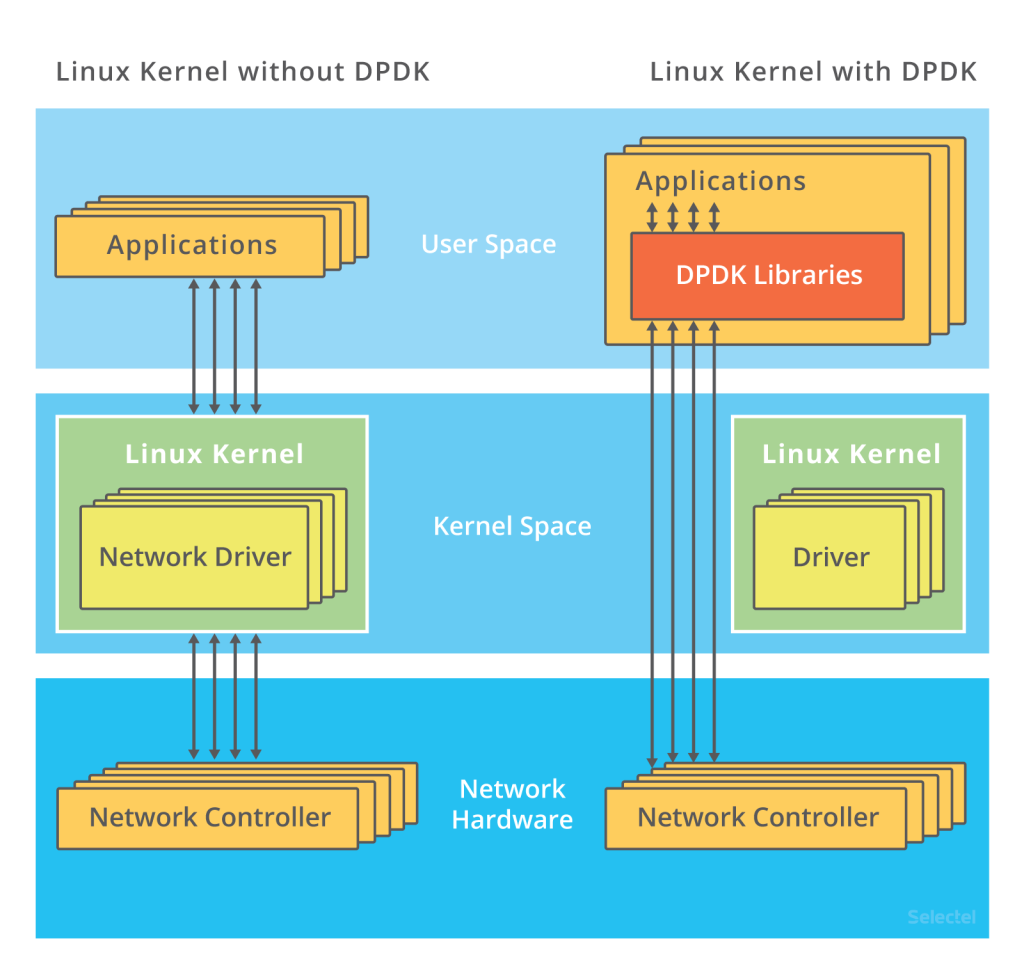Recently, data is the new currency. Every industry is generating and processing vast amounts of data in real-time. With the ever-increasing demand for high-speed and low-latency networks, network infrastructure has become a critical part of every organization’s strategy. To meet these demands, new technologies are being developed to optimize network performance, and one of the most promising among them is the Data Plane Development Kit (DPDK). Let’s explore about DPDK with Techzvn.net.
What is Data Plane Development Kit (DPDK)?
The Data Plane Development Kit (DPDK) is a set of libraries and drivers that enable fast packet processing in the user space. It was developed by Intel in 2010 and released as an open-source project under the Linux Foundation. The DPDK provides a set of optimized libraries for network interface cards (NICs) to bypass the kernel networking stack and directly access the hardware, which significantly reduces packet processing latency and increases throughput.
Why DPDK?
Traditional network architectures rely on kernel-based networking stacks to process packets. The kernel networking stack is designed to be flexible and feature-rich, but it adds significant overhead, which can become a bottleneck for high-speed networks. The kernel networking stack requires context switching between user space and kernel space, which slows down packet processing and increases latency.
The data plane development kit overcomes these limitations by providing a set of optimized libraries that allow user space applications to directly access the NICs, bypassing the kernel networking stack. This reduces the packet processing latency and increases throughput, enabling network applications to handle more traffic with less CPU utilization.
The DPDK Architecture

The DPDK architecture consists of three main components: the DPDK core, the DPDK drivers, and the DPDK libraries.
The DPDK core is the central component of the DPDK architecture. It manages the memory, interrupts, and scheduling of packets, providing a framework for packet processing in user space.
The DPDK drivers are responsible for interfacing with the hardware. They provide a set of APIs to manage the NICs, such as initialization, configuration, and memory mapping.
The DPDK libraries are a set of optimized libraries that provide low-level access to the hardware. These libraries are designed to be lightweight and efficient, allowing user space applications to bypass the kernel networking stack and access the hardware directly.
Benefits of DPDK
The data plane development kit provides several benefits over traditional kernel-based networking stacks, including:
- High Performance: The DPDK provides high-speed packet processing by bypassing the kernel networking stack and performing all network I/O operations in user space. This approach reduces packet processing latency, increases throughput, and improves scalability, making it an ideal solution for data-intensive applications.
- Scalability: The DPDK is designed to scale across multiple cores and can distribute packet processing across multiple threads, providing optimal performance for multi-core systems.
- Flexibility: The DPDK is an open-source framework that can be customized and tailored to specific application needs. It provides a range of APIs and libraries for different networking functions, such as packet I/O, routing, and filtering, and can be used with a variety of programming languages.
- Compatibility: The DPDK is designed to work with a wide range of hardware platforms and network interface cards (NICs). It supports various NIC features, such as multiple transmit and receive queues, hardware offloading, and packet filtering, enabling optimal performance for a variety of network architectures.
- Cost-effective: The DPDK is a software-based solution that runs on commodity hardware, making it a cost-effective alternative to specialized hardware solutions such as smart NICs or FPGA-based NICs.
- Low Latency: The DPDK is optimized for low latency and is used in software applications that require real-time packet processing, such as telecommunications, financial trading, and cloud computing.
- Security: The DPDK can be used to implement high-performance intrusion detection and prevention systems (IDPS) that analyze network traffic in real-time, enabling organizations to identify and respond to security threats quickly.
DPDK Challenges
While the data plane development kit offers many benefits, it also presents some challenges.
- Complexity: The DPDK requires specialized programming skills and knowledge of low-level networking concepts, making it challenging for developers who are not familiar with these topics.
- Compatibility: The DPDK requires hardware that supports the required features, such as multi-queue NICs and non-uniform memory access (NUMA) architectures, which may limit its compatibility with older hardware.
- Maintenance: The DPDK is a complex software stack that requires ongoing maintenance to keep up with changes in the hardware and software ecosystem.
DPDK Applications
The data plane development kit is used in a wide range of applications, including:
1. Telecommunications:

The DPDK is widely used in telecommunications networks, such as 4G and 5G wireless networks, to provide high-speed packet processing and low latency. In telecommunications networks, the DPDK is used for functions such as packet classification, load balancing, and traffic shaping.
2. Cloud Computing:
The DPDK is used in cloud computing environments, such as data centers, to improve network performance and reduce latency. In cloud computing environments, the DPDK is used for functions such as virtual machine networking, network function virtualization (NFV), and software-defined networking (SDN).
3. Big Data:
The DPDK is used in big data environments, such as Hadoop clusters, to accelerate data processing and reduce latency. In big data environments, the DPDK is used for functions such as data ingestion, data filtering, and data transformation.
4. Cybersecurity:
The DPDK is used in cybersecurity applications, such as intrusion detection and prevention systems (IDPS), to provide real-time packet processing and analysis. In cybersecurity applications, the DPDK is used for functions such as traffic analysis, signature-based detection, and anomaly detection.
5. Internet of Things (IoT):

The data plane development kit is used in IoT applications, such as industrial automation and smart cities, to provide high-speed packet processing for real-time data analysis and control. In IoT applications, the data plane development kit is used for functions such as data collection, data processing, and data communication.
Conclusion
The Data Plane Development Kit (DPDK) is a revolutionary technology that enables high-speed packet processing in user space. By bypassing the kernel networking stack, the DPDK reduces packet processing latency, increases throughput, and improves scalability. The DPDK is used in a wide range of applications, including telecommunications, cloud computing, big data, cybersecurity, and IoT.
While the DPDK presents some challenges, its benefits make it an attractive solution for organizations that require high-speed and low-latency networks. With the continued growth of data-driven industries, the data plane development kit will play an increasingly important role in optimizing network performance and enabling new applications and services that were previously not possible.
